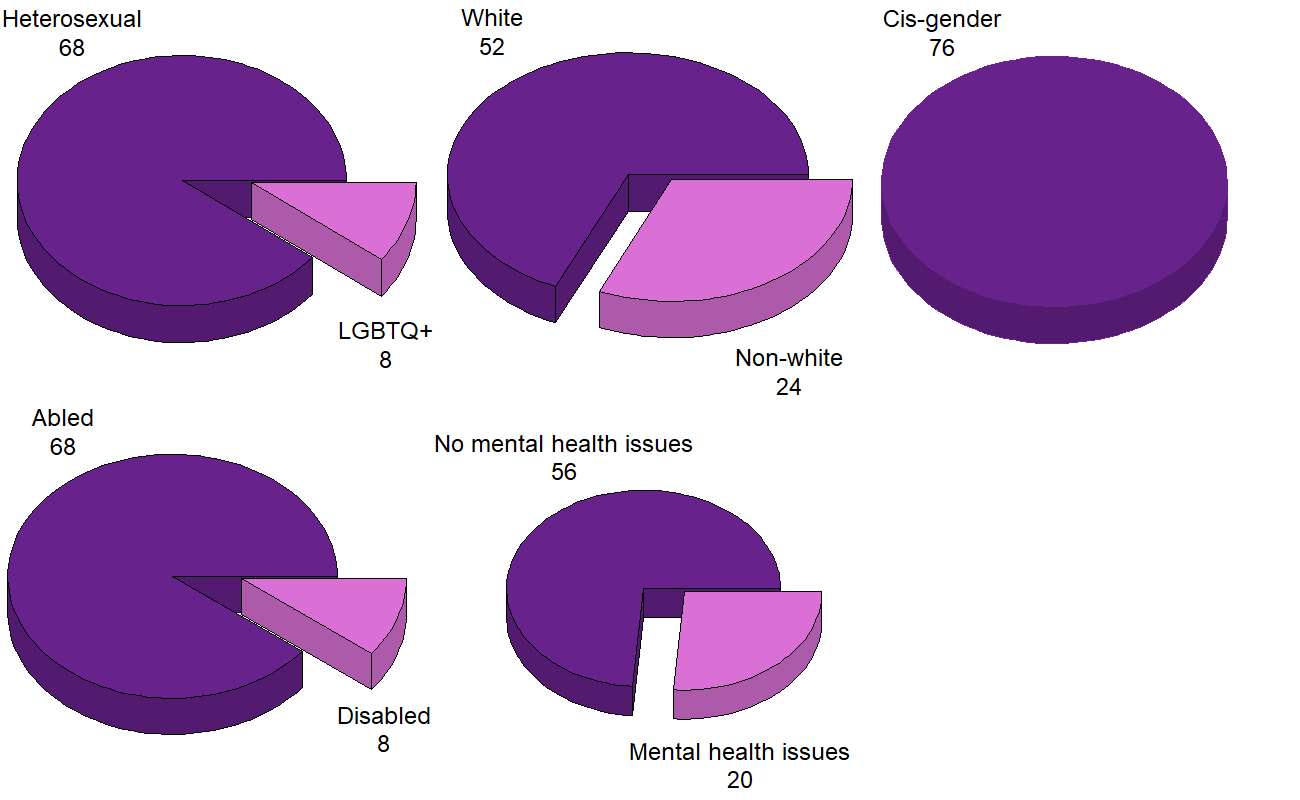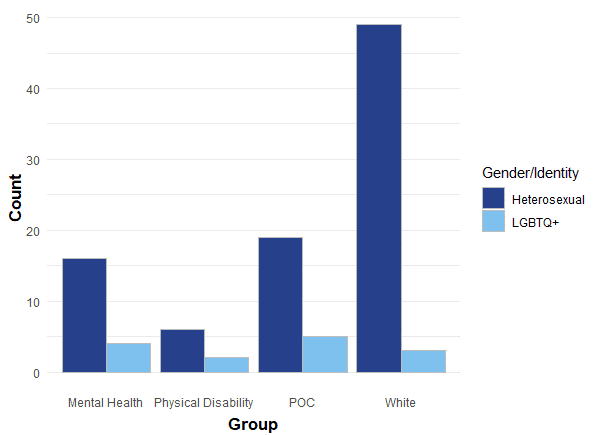Back
Adolescent Medicine: General
Category: Abstract Submission
Adolescent Medicine I
485 - An Examination of LGBTQ+, Minority, and Disability Representation in Best-Selling YA Novels
Friday, April 22, 2022
6:15 PM – 8:45 PM US MT
Poster Number: 485
Publication Number: 485.100
Publication Number: 485.100
Reta Behnam, Cohen Children's Medical Center, el cajon, CA, United States; Mary R. O'Connor, Cohen Children's Medical Center, New City, NY, United States; Duy Q. Pham, Cohen Children's Medical Center, New York, NY, United States; Allison Lin, Cohen Children's Medical Center, Port Washington, NY, United States; Ruth Milanaik, Donald and Barbara Zucker School of Medicine at Hofstra/Northwell, Great Neck, NY, United States
- DP
Duy Q. Pham, BA
Feinstein Visiting Scholar
Cohen Children's Medical Center
New York, New York, United States
Presenting Author(s)
Background: Media reflects and affirms society’s norms. Historically, most characters in print media for youth have been cisgender, heterosexual, white, and able-bodied, lacking diversity in terms of gender, sexual orientation, race, and disability. Young Adult (YA) novels are of special interest because they are specifically marketed to adolescents, and most characters mirror the formative age range of the audience. Despite recent efforts to diversify media, there has been no quantitative analysis of these efforts’ success in terms of representation of gender, sexual, and racial minorities and characters with disabilities in popular YA literature.
Objective: To quantify LGBTQ+, minority, and disability representation in top YA novels.
Design/Methods: All novels on the New York Times’ YA monthly paperback bestseller list starting from its earliest available date (October 2019) through present were analyzed. After excluding sequels and repeated appearances on the list, 44 books out of 210 total entries and 76 main characters were analyzed for their representation of sexual identity, gender identity, race, ethnicity, physical disabilities, and mental health concerns.
Results: Of the 76 characters, 10.5% (n=8) identified as part of the LGBTQ+ community, and 0% (n=0) were transgender or nonbinary. In addition, 68.4% (n=52) of characters were white. 89.5% (n=68) were able-bodied, and 73.7% (n=56) had no mental health concerns. Measures of interaction between the categories revealed that 46.1% (n=35) of characters represented no minority groups, as they were cisgender, heterosexual, white, and had no physical/mental disabilities.Conclusion(s): This analysis reveals that popular YA novels contain little to no representation of racial minority, LGBTQ+, or disability/neurodiverse identities. Because such books shape young readers’ understanding of the world, overrepresentation of white, heterosexual characters may establish this identity as the default, excluding many identities from the image of a “normal” teenage experience. A lack of characters that affirm a wide variety of experiences can lead to low self-worth in young readers of underrepresented identities, exacerbating feelings of internalized homophobia, transphobia, racism, and ableism. Pediatricians and school curricula should recommend books that represent a multitude of identities and experiences in order to ensure that all adolescents can connect with characters in a healthy, identity-affirming way.
Figure 1: Categories of Character Representation. Of the 76 characters, only 8 (10.5%) were part of the LGBTQ+ community and 0 (0%) were transgender or non binary. 52 (68.4%) were white, 68 (89.5%) were able bodied, and 56 (73.7%) were of sound mental health.
Of the 76 characters, only 8 (10.5%) were part of the LGBTQ+ community and 0 (0%) were transgender or non binary. 52 (68.4%) were white, 68 (89.5%) were able bodied, and 56 (73.7%) were of sound mental health.
Figure 2: Intersectionality of Character Identities. Of the 20 characters with mental health issues and of the 8 characters that were disabled, 4 (20.0%) and 2 (25.0%) identified as LGBTQ+, respectively. Of the 24 characters that were people of color (POC) and of the 52 white characters, only 5 (20.8%) and 3 (5.8%) were identified as LGBTQ+, respectively.
Of the 20 characters with mental health issues and of the 8 characters that were disabled, 4 (20.0%) and 2 (25.0%) identified as LGBTQ+, respectively. Of the 24 characters that were people of color (POC) and of the 52 white characters, only 5 (20.8%) and 3 (5.8%) were identified as LGBTQ+, respectively.
Objective: To quantify LGBTQ+, minority, and disability representation in top YA novels.
Design/Methods: All novels on the New York Times’ YA monthly paperback bestseller list starting from its earliest available date (October 2019) through present were analyzed. After excluding sequels and repeated appearances on the list, 44 books out of 210 total entries and 76 main characters were analyzed for their representation of sexual identity, gender identity, race, ethnicity, physical disabilities, and mental health concerns.
Results: Of the 76 characters, 10.5% (n=8) identified as part of the LGBTQ+ community, and 0% (n=0) were transgender or nonbinary. In addition, 68.4% (n=52) of characters were white. 89.5% (n=68) were able-bodied, and 73.7% (n=56) had no mental health concerns. Measures of interaction between the categories revealed that 46.1% (n=35) of characters represented no minority groups, as they were cisgender, heterosexual, white, and had no physical/mental disabilities.Conclusion(s): This analysis reveals that popular YA novels contain little to no representation of racial minority, LGBTQ+, or disability/neurodiverse identities. Because such books shape young readers’ understanding of the world, overrepresentation of white, heterosexual characters may establish this identity as the default, excluding many identities from the image of a “normal” teenage experience. A lack of characters that affirm a wide variety of experiences can lead to low self-worth in young readers of underrepresented identities, exacerbating feelings of internalized homophobia, transphobia, racism, and ableism. Pediatricians and school curricula should recommend books that represent a multitude of identities and experiences in order to ensure that all adolescents can connect with characters in a healthy, identity-affirming way.
Figure 1: Categories of Character Representation.
 Of the 76 characters, only 8 (10.5%) were part of the LGBTQ+ community and 0 (0%) were transgender or non binary. 52 (68.4%) were white, 68 (89.5%) were able bodied, and 56 (73.7%) were of sound mental health.
Of the 76 characters, only 8 (10.5%) were part of the LGBTQ+ community and 0 (0%) were transgender or non binary. 52 (68.4%) were white, 68 (89.5%) were able bodied, and 56 (73.7%) were of sound mental health.Figure 2: Intersectionality of Character Identities.
 Of the 20 characters with mental health issues and of the 8 characters that were disabled, 4 (20.0%) and 2 (25.0%) identified as LGBTQ+, respectively. Of the 24 characters that were people of color (POC) and of the 52 white characters, only 5 (20.8%) and 3 (5.8%) were identified as LGBTQ+, respectively.
Of the 20 characters with mental health issues and of the 8 characters that were disabled, 4 (20.0%) and 2 (25.0%) identified as LGBTQ+, respectively. Of the 24 characters that were people of color (POC) and of the 52 white characters, only 5 (20.8%) and 3 (5.8%) were identified as LGBTQ+, respectively.